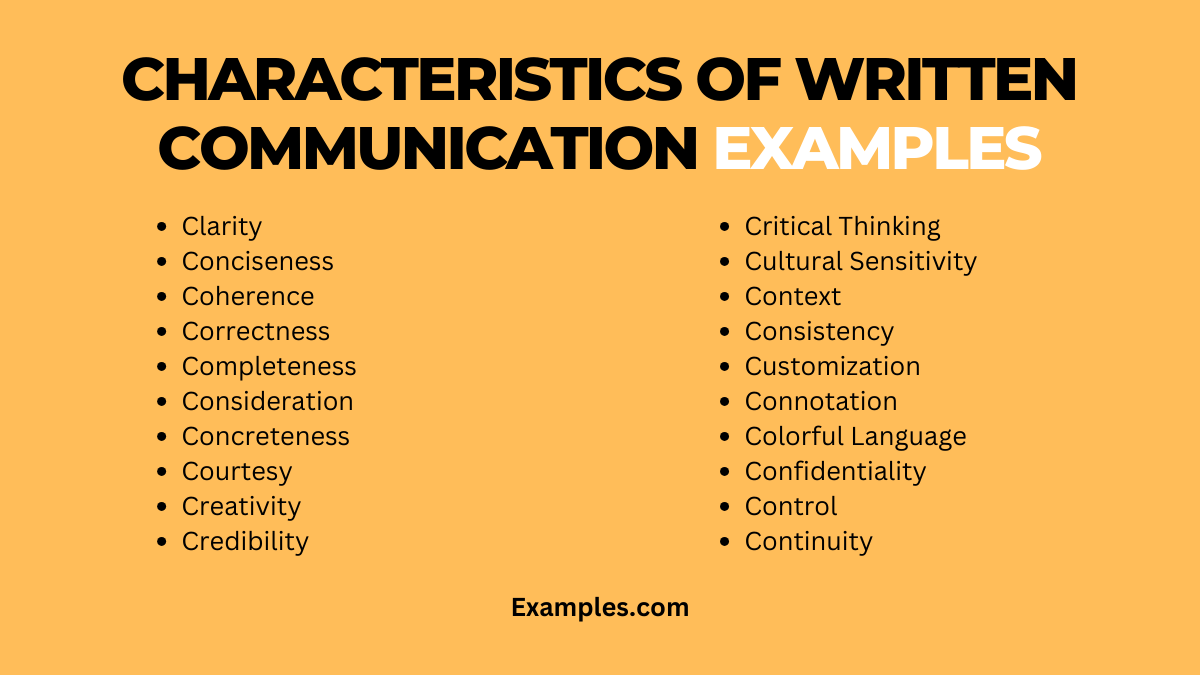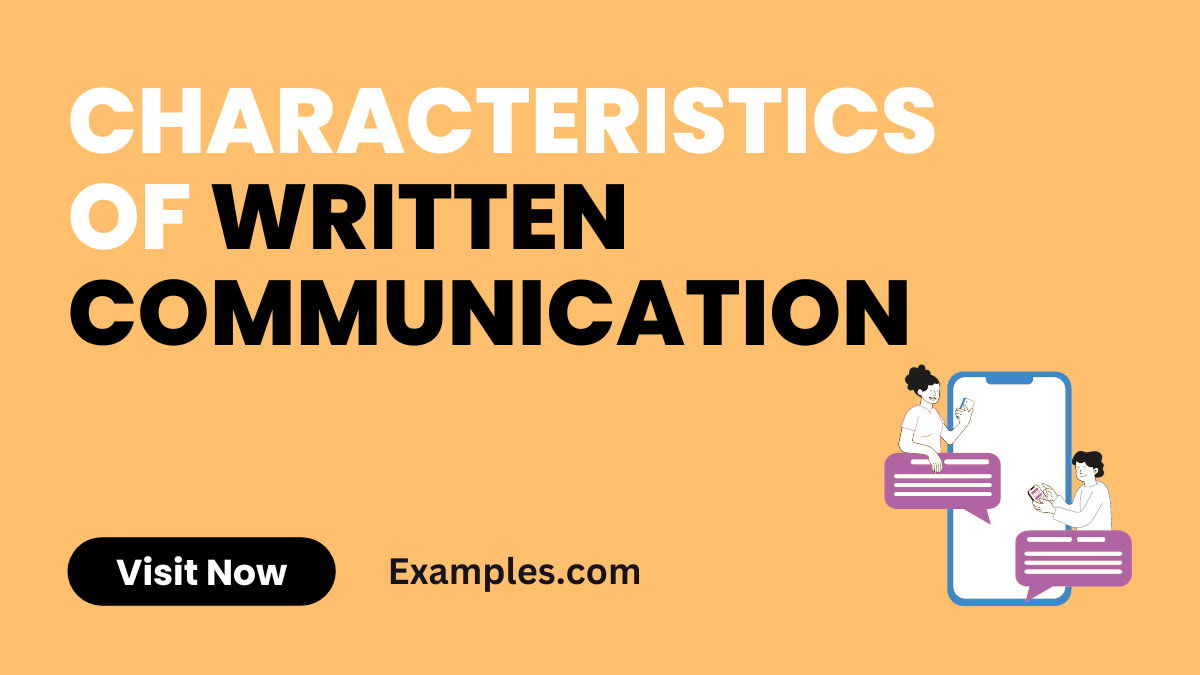19+ Characteristics of Written Communication Examples
Dive into our comprehensive guide on the Characteristics of Written Communication, where clarity meets creativity. Learn through vivid Communication Examples how to craft messages that resonate and achieve objectives. Whether it’s for professional or personal growth, understanding these characteristics can significantly enhance the effectiveness and precision of your written communication.
What are the Characteristics of Written Communication? – Meaning

The characteristics of written communication refer to the inherent qualities that make written messages effective and clear. These include clarity, conciseness, coherence, correctness, and completeness. Written communication is distinct in its ability to be recorded, referenced, and revised, making it a critical tool for conveying complex and detailed information precisely.
What is the Best Example of Characteristics of Written Communication?

The best example of integrated marketing communication (IMC) is a campaign that seamlessly combines multiple communication methods and channels — like social media, TV ads, and email marketing — to deliver a consistent message about a product or service. A notable instance is a major brand launching a new product, using a mix of advertising, public relations, direct marketing, and digital campaigns, all featuring unified messaging that strengthens brand identity, reaches diverse audiences, and drives consumer action.
20 Characteristics of Written Communication Examples

Understanding the characteristics of written communication is vital for effective expression and understanding. This involves a comprehensive look at the various elements that make written communication successful and impactful. By incorporating these characteristics effectively and addressing common issues, anyone can enhance the quality and impact of their Written Communication Sentence Examples, crucial in understanding the Importance of Written Communication and creating impactful Written Communication Examples and sentences. Here are 20 unique examples of characteristics along with explanations and fixes for common issues:
- Clarity: Unclear writing confuses readers. Fix: Use simple language and define technical terms.
- Conciseness: Overly wordy messages lose reader’s interest. Fix: Eliminate unnecessary words and get straight to the point.
- Coherence: Disorganized content confuses readers. Fix: Organize thoughts logically and use transitions.
- Correctness: Grammatical errors undermine credibility. Fix: Proofread and use grammar checking tools.
- Completeness: Incomplete messages lead to misunderstandings. Fix: Ensure all necessary information is included.
- Consideration: Ignoring the audience’s needs alienates them. Fix: Tailor your message to the audience’s level of understanding.
- Concreteness: Vague statements weaken impact. Fix: Use specific facts and figures.
- Courtesy: Disrespectful tone offends readers. Fix: Be polite and respectful in all communications.
- Creativity: Dull writing fails to engage. Fix: Use vivid words and vary sentence structure.
- Credibility: Untrustworthy sources or data reduce impact. Fix: Cite reliable sources and provide evidence.
- Critical Thinking: Lack of analysis leads to superficial content. Fix: Evaluate and synthesize information before writing.
- Cultural Sensitivity: Cultural misunderstandings offend or confuse. Fix: Understand and respect cultural differences.
- Context: Ignoring context leads to irrelevant messages. Fix: Consider the situation and relevant factors.
- Consistency: Inconsistent messages confuse readers. Fix: Maintain a steady tone and style.
- Customization: Generic messages lack personal touch. Fix: Adapt the message for specific audiences.
- Connotation: Misunderstood implications change message impact. Fix: Choose words with appropriate connotations.
- Colorful Language: Overuse of metaphors or idioms confuses. Fix: Use descriptive but straightforward language.
- Confidentiality: Inappropriate sharing of information leads to breaches. Fix: Share sensitive information judiciously.
- Control: Rambling messages lose focus. Fix: Stay on topic and keep paragraphs focused.
- Continuity: Lack of flow disrupts understanding. Fix: Link ideas and ensure smooth transitions.
Characteristics of Written Communication for Students
Students must master certain characteristics of written communication to excel academically and develop effectively. Engaging with Written Communication in Schools and regularly contributing to a Written Communication Journal can significantly enhance their skills. Here are five examples for students:
- Organization: Essays and reports require logical structure. “Start with an outline, then expand each section.”
- Tone Adaptation: Different assignments need different tones. “Use a formal tone for essays, conversational for reflections.”
- Precision: Accurate and concise language is key. “Choose words that precisely convey your meaning.”
- Source Citing: Academic integrity through proper referencing. “Use APA or MLA style for citations.”
- Revision: Continual improvement through feedback. “Revise drafts based on teacher and peer feedback.”
Download Importance of Written Communication for Education
Characteristics of Written Communication for Interview
Effective written communication is crucial in professional settings, especially during the interview process, reflecting Written Communication in the Workplace, particularly in Written Communication in Nursing and Written Communication in Healthcare. Here are five key characteristics to excel:
- Clarity: Convey your qualifications and fit clearly. “State clearly how your experience aligns with the job requirements.”
- Brevity: Keep responses concise and to the point. “Summarize your achievements in a few impactful sentences.”
- Professionalism: Use a formal and respectful tone. “Address the interviewer by title and last name unless otherwise indicated.”
- Customization: Tailor your communication to the company. “Reference specific company values or projects in your cover letter.”
- Follow-Up: A thank-you note post-interview. “Send a brief, polite email thanking the interviewer for their time and consideration.”
What is the Importance of Characteristics of Written Communication?
Understanding the importance of the characteristics of written communication is crucial in every field, particularly in Written Communication in Education. It ensures that the message is clear, effective, and appropriate for the audience. Here are five reasons highlighting its importance:
- Enhances Clarity: Clear communication eliminates misunderstandings and conveys messages effectively.
- Promotes Efficiency: Efficient communication saves time and resources by avoiding repetitive clarification.
- Builds Professionalism: Well-crafted messages reflect professionalism and competence.
- Facilitates Record Keeping: Written communication provides a permanent record of exchanges and decisions.
- Supports Legal Compliance: Accurate and clear written communication is essential for legal and regulatory documentation.
What are the Components of Characteristics of Written Communication?
The components of characteristics of written communication form the foundation of effective writing, crucial in Written Communication in Schools and for enhancing Written Communication in the Classroom. Here are five key components:
- Purpose and Audience: Understanding why you are writing and who you are writing to is fundamental.
- Structure and Organization: A logical flow makes the communication more understandable and engaging.
- Style and Tone: The way the message is conveyed should be appropriate for the context and audience.
- Language and Word Choice: Using precise and clear language avoids confusion and makes the message more impactful.
- Revision and Feedback: Continual improvement through editing and incorporating feedback ensures the communication is at its best.
Effective written Communication Skills encompass several key characteristics. Clarity and conciseness are paramount, ensuring messages are easily understood. Proper grammar and punctuation contribute to professionalism and comprehension. Tailoring the message to the audience is vital, adapting style and tone accordingly. Proofreading and seeking feedback are essential steps to enhance these skills. In summary, mastering these characteristics is crucial for achieving Effective Communication.
What are the Characteristics and Advantages of Written communication?
The characteristics of written communication include clarity, conciseness, and coherence, leading to advantages like permanent record, precision, and wide dissemination. Enhancing these furthers How to Improve Written Communication.
How Can Technology Influence the Characteristics of Written Communication?
Technology offers tools for improving grammar, style, and delivery, thus enhancing the characteristics of written communication. It facilitates broader and more efficient distribution and refinement.
What Role does Clarity Play in the Characteristics of Written Communication?
Clarity is paramount in written communication, ensuring messages are understood as intended. It reduces misunderstandings and increases the effectiveness and professionalism of the communication.
In conclusion, the characteristics of written communication are essential for conveying clear, precise, and impactful messages. By understanding and implementing strategies to improve clarity, conciseness, and coherence, individuals can enhance their communication skills, leading to better understanding, collaboration, and professional success. Recognizing the signs of ineffective communication and applying targeted fixes is crucial in this continuous journey of improvement.
19+ Characteristics of Written Communication Examples

Dive into our comprehensive guide on the Characteristics of Written Communication, where clarity meets creativity. Learn through vivid Communication Examples how to craft messages that resonate and achieve objectives. Whether it’s for professional or personal growth, understanding these characteristics can significantly enhance the effectiveness and precision of your written communication.
What are the Characteristics of Written Communication? – Meaning

The characteristics of written communication refer to the inherent qualities that make written messages effective and clear. These include clarity, conciseness, coherence, correctness, and completeness. Written communication is distinct in its ability to be recorded, referenced, and revised, making it a critical tool for conveying complex and detailed information precisely.
What is the Best Example of Characteristics of Written Communication?

The best example of integrated marketing communication (IMC) is a campaign that seamlessly combines multiple communication methods and channels — like social media, TV ads, and email marketing — to deliver a consistent message about a product or service. A notable instance is a major brand launching a new product, using a mix of advertising, public relations, direct marketing, and digital campaigns, all featuring unified messaging that strengthens brand identity, reaches diverse audiences, and drives consumer action.
20 Characteristics of Written Communication Examples

Understanding the characteristics of written communication is vital for effective expression and understanding. This involves a comprehensive look at the various elements that make written communication successful and impactful. By incorporating these characteristics effectively and addressing common issues, anyone can enhance the quality and impact of their Written Communication Sentence Examples, crucial in understanding the Importance of Written Communication and creating impactful Written Communication Examples and sentences. Here are 20 unique examples of characteristics along with explanations and fixes for common issues:
Clarity: Unclear writing confuses readers. Fix: Use simple language and define technical terms.
Conciseness: Overly wordy messages lose reader’s interest. Fix: Eliminate unnecessary words and get straight to the point.
Coherence: Disorganized content confuses readers. Fix: Organize thoughts logically and use transitions.
Correctness: Grammatical errors undermine credibility. Fix: Proofread and use grammar checking tools.
Completeness: Incomplete messages lead to misunderstandings. Fix: Ensure all necessary information is included.
Consideration: Ignoring the audience’s needs alienates them. Fix: Tailor your message to the audience’s level of understanding.
Concreteness: Vague statements weaken impact. Fix: Use specific facts and figures.
Courtesy: Disrespectful tone offends readers. Fix: Be polite and respectful in all communications.
Creativity: Dull writing fails to engage. Fix: Use vivid words and vary sentence structure.
Credibility: Untrustworthy sources or data reduce impact. Fix: Cite reliable sources and provide evidence.
Critical Thinking: Lack of analysis leads to superficial content. Fix: Evaluate and synthesize information before writing.
Cultural Sensitivity: Cultural misunderstandings offend or confuse. Fix: Understand and respect cultural differences.
Context: Ignoring context leads to irrelevant messages. Fix: Consider the situation and relevant factors.
Consistency: Inconsistent messages confuse readers. Fix: Maintain a steady tone and style.
Customization: Generic messages lack personal touch. Fix: Adapt the message for specific audiences.
Connotation: Misunderstood implications change message impact. Fix: Choose words with appropriate connotations.
Colorful Language: Overuse of metaphors or idioms confuses. Fix: Use descriptive but straightforward language.
Confidentiality: Inappropriate sharing of information leads to breaches. Fix: Share sensitive information judiciously.
Control: Rambling messages lose focus. Fix: Stay on topic and keep paragraphs focused.
Continuity: Lack of flow disrupts understanding. Fix: Link ideas and ensure smooth transitions.
Characteristics of Written Communication for Students
Students must master certain characteristics of written communication to excel academically and develop effectively. Engaging with Written Communication in Schools and regularly contributing to a Written Communication Journal can significantly enhance their skills. Here are five examples for students:
Organization: Essays and reports require logical structure. “Start with an outline, then expand each section.”
Tone Adaptation: Different assignments need different tones. “Use a formal tone for essays, conversational for reflections.”
Precision: Accurate and concise language is key. “Choose words that precisely convey your meaning.”
Source Citing: Academic integrity through proper referencing. “Use APA or MLA style for citations.”
Revision: Continual improvement through feedback. “Revise drafts based on teacher and peer feedback.”
Download Importance of Written Communication for Education
Characteristics of Written Communication for Interview
Effective written communication is crucial in professional settings, especially during the interview process, reflecting Written Communication in the Workplace, particularly in Written Communication in Nursing and Written Communication in Healthcare. Here are five key characteristics to excel:
Clarity: Convey your qualifications and fit clearly. “State clearly how your experience aligns with the job requirements.”
Brevity: Keep responses concise and to the point. “Summarize your achievements in a few impactful sentences.”
Professionalism: Use a formal and respectful tone. “Address the interviewer by title and last name unless otherwise indicated.”
Customization: Tailor your communication to the company. “Reference specific company values or projects in your cover letter.”
Follow-Up: A thank-you note post-interview. “Send a brief, polite email thanking the interviewer for their time and consideration.”
What is the Importance of Characteristics of Written Communication?
Understanding the importance of the characteristics of written communication is crucial in every field, particularly in Written Communication in Education. It ensures that the message is clear, effective, and appropriate for the audience. Here are five reasons highlighting its importance:
Enhances Clarity: Clear communication eliminates misunderstandings and conveys messages effectively.
Promotes Efficiency: Efficient communication saves time and resources by avoiding repetitive clarification.
Builds Professionalism: Well-crafted messages reflect professionalism and competence.
Facilitates Record Keeping: Written communication provides a permanent record of exchanges and decisions.
Supports Legal Compliance: Accurate and clear written communication is essential for legal and regulatory documentation.
What are the Components of Characteristics of Written Communication?
The components of characteristics of written communication form the foundation of effective writing, crucial in Written Communication in Schools and for enhancing Written Communication in the Classroom. Here are five key components:
Purpose and Audience: Understanding why you are writing and who you are writing to is fundamental.
Structure and Organization: A logical flow makes the communication more understandable and engaging.
Style and Tone: The way the message is conveyed should be appropriate for the context and audience.
Language and Word Choice: Using precise and clear language avoids confusion and makes the message more impactful.
Revision and Feedback: Continual improvement through editing and incorporating feedback ensures the communication is at its best.
Effective written Communication Skills encompass several key characteristics. Clarity and conciseness are paramount, ensuring messages are easily understood. Proper grammar and punctuation contribute to professionalism and comprehension. Tailoring the message to the audience is vital, adapting style and tone accordingly. Proofreading and seeking feedback are essential steps to enhance these skills. In summary, mastering these characteristics is crucial for achieving Effective Communication.
What are the Characteristics and Advantages of Written communication?
The characteristics of written communication include clarity, conciseness, and coherence, leading to advantages like permanent record, precision, and wide dissemination. Enhancing these furthers How to Improve Written Communication.
How Can Technology Influence the Characteristics of Written Communication?
Technology offers tools for improving grammar, style, and delivery, thus enhancing the characteristics of written communication. It facilitates broader and more efficient distribution and refinement.
What Role does Clarity Play in the Characteristics of Written Communication?
Clarity is paramount in written communication, ensuring messages are understood as intended. It reduces misunderstandings and increases the effectiveness and professionalism of the communication.
In conclusion, the characteristics of written communication are essential for conveying clear, precise, and impactful messages. By understanding and implementing strategies to improve clarity, conciseness, and coherence, individuals can enhance their communication skills, leading to better understanding, collaboration, and professional success. Recognizing the signs of ineffective communication and applying targeted fixes is crucial in this continuous journey of improvement.


